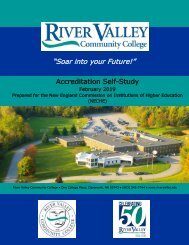Create successful ePaper yourself
Turn your PDF publications into a flip-book with our unique Google optimized e-Paper software.
Position and Procedures 1 course. Students and faculty reported finding the additional<br />
assistant helpful in preparing students for their clinical rotations.<br />
Job Descriptions (SJDs), Workloads, Responsibilities<br />
All faculty have specifically defined roles in the institution as defined by the CCSNH BoT<br />
policies referenced above as well as the full-time and adjunct CBA documents.<br />
CCSNH BoT policy 690 states that the “responsibilities of part-time [adjunct] faculty are<br />
limited to those accountabilities associated with teaching a course at the College.” The<br />
responsibilities expected of adjunct faculty include development of instructional materials,<br />
or usage of prepared instructional materials; and grading of their assigned course(s) work<br />
to meet the course objectives as defined in course outlines. Adjunct faculty are also<br />
expected to be available for student consultation before and after class or via electronic<br />
means as outlined in Section 9 – Workload of the 2017-18 Adjunct faculty CBA. Most<br />
adjunct faculty meet this requirement through electronic communications either via<br />
Canvas or e-mail. Some adjunct faculty, such as one of the Phlebotomy instructors sets<br />
aside 30 minutes after each class to be available to students; and adjunct faculty, such as<br />
one teaching Psychology, reserve classroom space each week to hold “office hours” in<br />
order to assist students.<br />
Full-time faculty have additional responsibilities including teaching and learning, academic<br />
contributions to a department and/or the College, service to students, service to college<br />
and community, and professional growth and development. The responsibilities of each<br />
faculty member are outlined in their Supplemental Job Description (the SJD). This SJD is<br />
available at the time of advertisement of each faculty position and also clearly outlines the<br />
requirement for appointment level (professor, associate professor, or assistant professor).<br />
All faculty are assigned to a specific program or department upon hire and their specific<br />
job responsibilities are outlined in their SJD. With appropriate credentials, faculty may<br />
teach in a discipline outside of their assigned program or department to fulfill the needs of<br />
the institution.<br />
All qualifications for teaching are overseen by the Office of Academics, specifically the<br />
VPAA, to ensure that all faculty applicants meet minimum qualifications. SJDs are revised<br />
upon promotion or as needed based on individual job requirements.<br />
River Valley ensures the proper qualifications of all full-time faculty. Since 2005, the<br />
minimum degree qualification for all full-time and adjunct faculty has been a Master’s<br />
degree. There are some exceptions to this policy made only for programs with<br />
accreditation standards that do not require a Master’s degree such as Massage Therapy,<br />
Medical Assisting, and Medical Laboratory Technician. Occasionally, exceptions have also<br />
been made for programs in which no qualified Master’s level faculty are otherwise<br />
available. In these situations, exceptions are typically made only when there is sufficient<br />
experience to offset the lack of Master’s degree. In addition to degrees, some faculty<br />
members hold certifications and licenses required by their profession. This is often the<br />
case in many programs in Nursing and Respiratory Care, Allied Health, and Health<br />
Sciences. In these cases, faculty are required to maintain certifications, licenses, and<br />
other criteria as dictated by the state or federal requirements or by the individual program<br />
80 | P a g e





